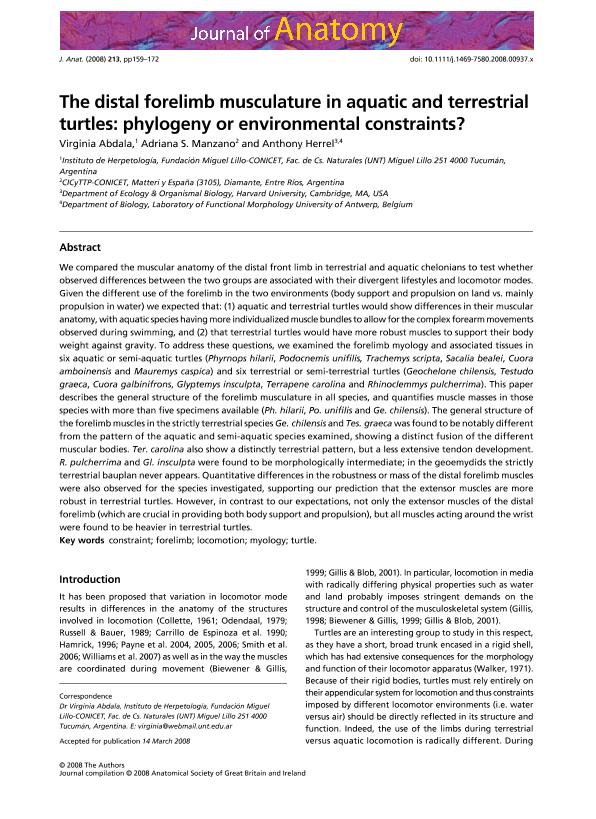Artículo
The distal forelimb musculature in aquatic and terrestrial turtles: phylogeny or enviromental constraint?
Fecha de publicación:
12/2008
Editorial:
Wiley Blackwell Publishing, Inc
Revista:
Journal of Anatomy
ISSN:
0021-8782
Idioma:
Inglés
Tipo de recurso:
Artículo publicado
Clasificación temática:
Resumen
We compared the muscular anatomy of the distal front limb in terrestrial and aquatic chelonians to test whether observed differences between the two groups are associated with their divergent lifestyles and locomotor modes. Given the different use of the forelimb in the two environments (body support and propulsion on land vs. mainly propulsion in water) we expected that: (1) aquatic and terrestrial turtles would show differences in their muscular anatomy, with aquatic species having more individualized muscle bundles to allow for the complex forearm movements observed during swimming, and (2) that terrestrial turtles would have more robust muscles to support their body weight against gravity. To address these questions, we examined the forelimb myology and associated tissues in six aquatic or semi‐aquatic turtles (Phyrnops hilarii, Podocnemis unifilis, Trachemys scripta, Sacalia bealei, Cuora amboinensis and Mauremys caspica) and six terrestrial or semi‐terrestrial turtles (Geochelone chilensis, Testudo graeca, Cuora galbinifrons, Glyptemys insculpta, Terrapene carolina and Rhinoclemmys pulcherrima). This paper describes the general structure of the forelimb musculature in all species, and quantifies muscle masses in those species with more than five specimens available (Ph. hilarii, Po. unifilis and Ge. chilensis). The general structure of the forelimb muscles in the strictly terrestrial species Ge. chilensis and Tes. graeca was found to be notably different from the pattern of the aquatic and semi‐aquatic species examined, showing a distinct fusion of the different muscular bodies. Ter. carolina also show a distinctly terrestrial pattern, but a less extensive tendon development. R. pulcherrima and Gl. insculpta were found to be morphologically intermediate; in the geoemydids the strictly terrestrial bauplan never appears. Quantitative differences in the robustness or mass of the distal forelimb muscles were also observed for the species investigated, supporting our prediction that the extensor muscles are more robust in terrestrial turtles. However, in contrast to our expectations, not only the extensor muscles of the distal forelimb (which are crucial in providing both body support and propulsion), but all muscles acting around the wrist were found to be heavier in terrestrial turtles.
Palabras clave:
Constraint
,
Forelimb-Locomotion
,
Myology
,
Turtle
Archivos asociados
Licencia
Identificadores
Colecciones
Articulos(CCT - NOA SUR)
Articulos de CTRO.CIENTIFICO TECNOL.CONICET - NOA SUR
Articulos de CTRO.CIENTIFICO TECNOL.CONICET - NOA SUR
Articulos(CICYTTP)
Articulos de CENTRO DE INV.CIENT.Y TRANSFERENCIA TEC A LA PROD
Articulos de CENTRO DE INV.CIENT.Y TRANSFERENCIA TEC A LA PROD
Citación
Abdala, Virginia Sara Luz; Manzano, Adriana Silvina; Herrel, Anthony; The distal forelimb musculature in aquatic and terrestrial turtles: phylogeny or enviromental constraint?; Wiley Blackwell Publishing, Inc; Journal of Anatomy; 213; 2; 12-2008; 159-172
Compartir
Altmétricas




